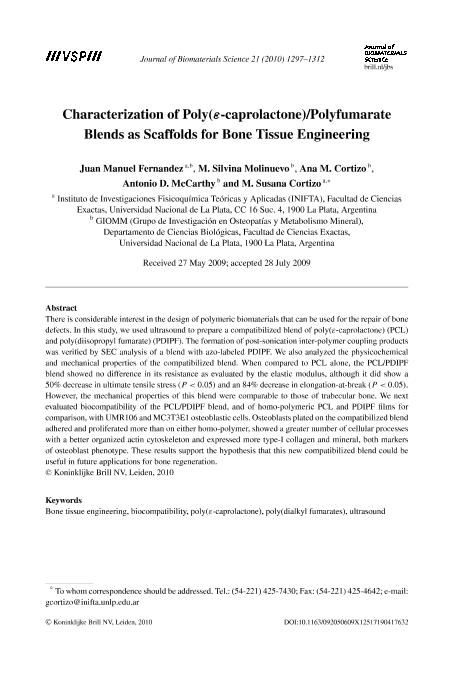Artículo
Characterization of poly(ε-caprolactone)/polyfumarate blends as scaffolds for bone tissue engineering
Fernández, Juan Manuel ; Molinuevo, María Silvina
; Molinuevo, María Silvina ; Cortizo, Ana María; McCarthy, Antonio Desmond; Cortizo, Maria Susana
; Cortizo, Ana María; McCarthy, Antonio Desmond; Cortizo, Maria Susana
 ; Molinuevo, María Silvina
; Molinuevo, María Silvina ; Cortizo, Ana María; McCarthy, Antonio Desmond; Cortizo, Maria Susana
; Cortizo, Ana María; McCarthy, Antonio Desmond; Cortizo, Maria Susana
Fecha de publicación:
06/2010
Editorial:
Vsp Bv
Revista:
Journal of Biomaterials Science - Polymer Edition
ISSN:
0920-5063
Idioma:
Inglés
Tipo de recurso:
Artículo publicado
Clasificación temática:
Resumen
There is considerable interest in the design of polymeric biomaterials that can be used for the repair of bone defects. In this study, we used ultrasound to prepare a compatibilized blend of poly(ε-caprolactone) (PCL) and poly(diisopropyl fumarate) (PDIPF). The formation of post-sonication inter-polymer coupling products was verified by SEC analysis of a blend with azo-labeled PDIPF. We also analyzed the physicochemical and mechanical properties of the compatibilized blend. When compared to PCL alone, the PCL/PDIPF blend showed no difference in its resistance as evaluated by the elastic modulus, although it did show a 50% decrease in ultimate tensile stress (P < 0.05) and an 84% decrease in elongation-at-break (P < 0.05). However, the mechanical properties of this blend were comparable to those of trabecular bone. We next evaluated biocompatibility of the PCL/PDIPF blend, and of homo-polymeric PCL and PDIPF films for comparison, with UMR106 and MC3T3E1 osteoblastic cells. Osteoblasts plated on the compatibilized blend adhered and proliferated more than on either homo-polymer, showed a greater number of cellular processes with a better organized actin cytoskeleton and expressed more type-I collagen and mineral, both markers of osteoblast phenotype. These results support the hypothesis that this new compatibilized blend could be useful in future applications for bone regeneration.
Archivos asociados
Licencia
Identificadores
Colecciones
Articulos(SEDE CENTRAL)
Articulos de SEDE CENTRAL
Articulos de SEDE CENTRAL
Citación
Fernández, Juan Manuel; Molinuevo, María Silvina; Cortizo, Ana María; McCarthy, Antonio Desmond; Cortizo, Maria Susana; Characterization of poly(ε-caprolactone)/polyfumarate blends as scaffolds for bone tissue engineering; Vsp Bv; Journal of Biomaterials Science - Polymer Edition; 21; 10; 6-2010; 1297-1312
Compartir
Altmétricas



